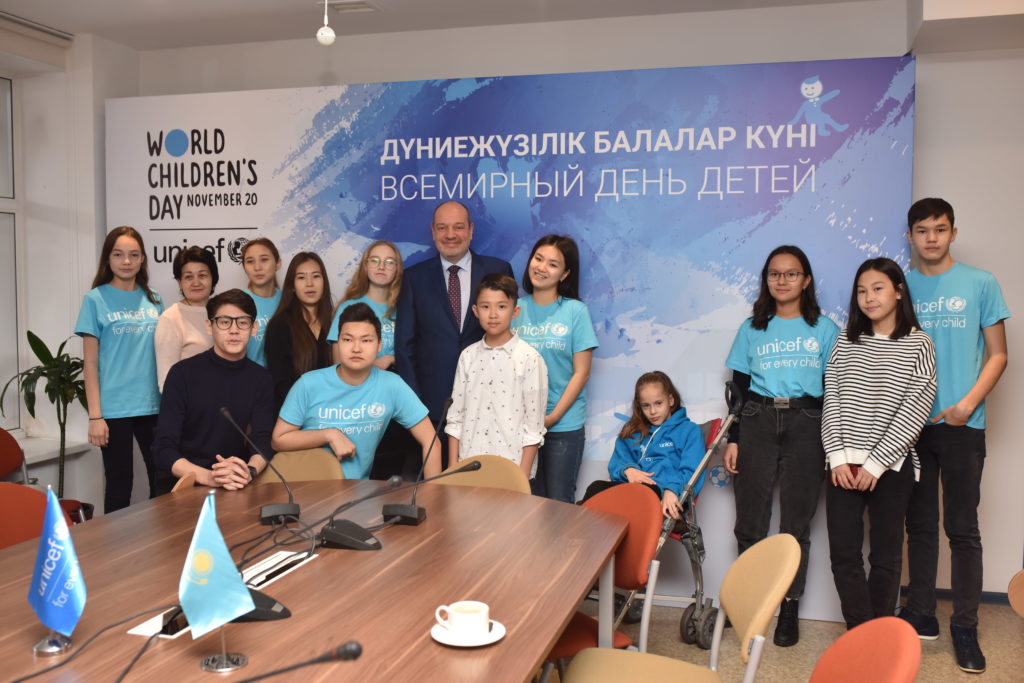NUR-SULTAN – The United Nations Children’s Fund (UNICEF) presented its analysis of the situation of Kazakhstan’s children Nov. 19 in Nur-Sultan.

UNICEF Representative in Kazakhstan Arthur van Diesen and children from high schools at the presentation on Nov.19 in Nur-Sultan. Photo credit: UNICEF Kazakhstan.
The analysis observes the country’s achievements, including progress in reducing child and maternal mortality; increasing enrolment in education, including preschool; and creating conditions for inclusive education. It also reveals gaps and issues that require special attention.
“Today is a special day for us because we celebrate the 30th anniversary of the Convention on the Rights of the Child and the 25th anniversary of Kazakhstan’s ratifying this convention. On this day we are launching an analysis on the situation of children in Kazakhstan, in which we recognise progress Kazakhstan has made in terms of protecting the rights of children. We also highlight the work that remains to be done. On the side of the achievements we highlight, for example, the fact that infant and under-five mortality has reduced greatly since independence,” said UNICEF representative in Kazakhstan Arthur van Diesen.
Almost every child also now has a place in primary school and preschool education has also expanded dramatically.
“But there are challenges ahead as well,” noted Diesen. “There’s still ways to go to make Kazakhstan truly inclusive society. When we look at children with disabilities, it is still difficult for them to fully realise their rights and to have a fulfilling role in society that starts even with education. We still see, even though more and more schools are accessible, that not every child can find a place in a regular school to study and prepare for adult life.”
Nutrition is also a problem. Kazakhstan is facing what has been dubbed the double burden of malnutrition – when undernutrition exists at the same time as a growing number of young people are observed to be overweight, and micro-nutrition deficiencies, such as iron deficiency, are also observed.
UNICEF plans to conduct a study of obesity among children in 2020. If the current trend toward obesity is not altered, children born in 2050 may have shorter lives than children born today. Obesity could become one of the two main causes of mortality.
“It will be conducted in 170 schools among children from eight to 10. The study will be conducted jointly with UNICEF, [the World Health Organisation] WHO and the National Centre for Public Healthcare. It is the second round of the study, which is carried out every five years. Anthropometric studies will be used to measure children. Parents, teachers and school management will also be interviewed,” said UNICEF Kazakhstan Health and Nutrition Programme Coordinator Kanat Sukhanberdiyev.
The situation analysis is the first step in developing a country programme with the Kazakh government for 2021 to 2025. The analysis presents the government with UNICEF’s priorities for the coming years.
The country has maintained consistent levels of investment in the health, education and social sectors but they are lower than the averages for member countries of the Organisation for Economic Co-operation and Development (OECD).
The infant mortality rate or the number of deaths of children under one year of age decreased from 45 to nine per 1,000 live births between 1990 and 2017, according to the analysis. The maternal mortality rate has fallen dramatically from 92 deaths per 100,000 live births in 1995 to 14 deaths per 100,000 live births in 2018.
“Many parents do not know how to prevent health problems caused by poor hygiene or malnutrition that increase the risk of child morbidity and mortality. Home visiting nurses tend to focus on medical problems and lack skills to identify social risks and needs and take children’s and families’ individual characteristics into account,” reads the report.
Mother-to-child transmission of HIV was practically eliminated. Injury remains a leading cause of death and hospitalisation among children. In 2017, 4,189 children sustained injuries due to road accidents and 193 children died.
The number of children living in poverty has fallen dramatically since 2000. Some 15.6 percent of children live in households in the lowest income decile and inequality among regions in terms of child poverty is significant.
Death by suicide remains one of the leading causes of adolescent mortality in the country. Mental health disorders and challenges including depression and anxiety are linked to suicidal behaviour.
UNICEF also provides a list of recommendations to address the challenges. They include ensuring data quality and availability for effective policy development, monitoring and evaluation measures, and improving legislation and cross-sectoral coordination and management mechanisms.
The analysis was based on a comprehensive review of existing data and studies on children and women in the areas of health, nutrition, education, HIV, water and sanitation, the environment, child protection and social protection and participation in public life using state and international sources and statistics. Focus group discussions, semi-structured interviews and consultations with government officials, field visits and personal stories were used as sources.
Children from high schools spoke about preschool education, inclusion, nutrition, polluted air and participation in public life at the presentation. They expressed hope that their concerns can be heard to improve issues related to their lives and future.

